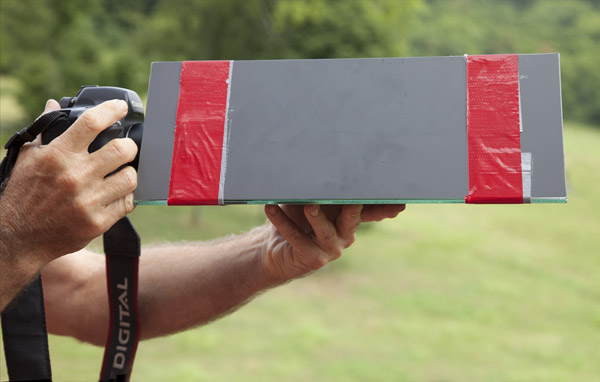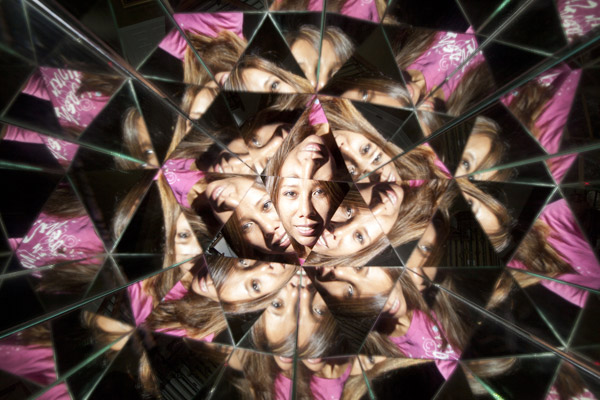Making A Kaleidoscope: “Fracturing” The View
I have long been intrigued with kaleidoscopic images, but it’s virtually impossible to photograph into a traditional kaleidoscope because the hole through which you look to see the beautiful designs is too small. Several years ago I figured out how to construct a kaleidoscope that would permit photography, and I’ve always had a lot of fun with it. The cost is around $5-$10, and it can be put together in just a few minutes.
Commercially manufactured kaleidoscopes have two mirrors inside of them set as a “V”. To take pictures, it’s necessary to add a third mirror to form a triangle. I went to a glass shop and asked them to cut three pieces of mirror measuring 6x12”. I had them smooth the edges of the glass so it wasn’t so sharp (this is important because cut glass is razor sharp), and now it was much safer to handle. To construct the kaleidoscope, I simply stood the mirrors on their ends and arranged them in a triangle such that the mirrored surface was inside. I used duct tape to hold the unit together, and voila!, a kaleidoscope was born.
To take a picture, I simply put the lens of the camera inside the triangle of mirrors, as you see in (figure A). The number of facets in the resulting photos increases as the width of your lens increases. I would recommend using at least a 24mm lens (on a full frame sensor camera), or an 18mm lens on a camera with a smaller sensor. If you have a wider angle lens, that’s great.

All Photos © Jim Zuckerman
You can hand hold the mirrored triangle as you shoot through it. For best results, a fairly small lens aperture is required to minimize an out of focus foreground. Use at least f/11, although f/16 to f/22 is ideal.
The images you get are intriguing. Try a diversity of subject matter—flowers, trees, people (kids have a lot of fun with this), architecture, color abstracts like a bowl of candy and colored construction paper, and so much more. For example, (#1) is a shot of the taillight on my car, (#2) shows lilies in bloom in my garden and (#3) is a kaleidoscopic image of my wife holding a flash at arm’s length.



A unique approach to using this technique is to place translucent colored gels on a surface like glass or even wire mesh. Then you can backlight it with a flash. In photos (#4 and #5), I placed colored gels on a drying rack for dishes. I rested the kaleidoscope on the rubberized framework as you can see in (figure B). I put the flash on the kitchen floor and angled it to illuminate the gels and then triggered it wirelessly. I set the camera to Manual Exposure mode and the flash to ETTL, and my lens aperture in this case was f/22. The backlighting made the colors of the gels come to life, and the rack provided a unique pattern seen through the colorful abstraction. Sometimes when you place the kaleidoscope near a subject it casts an unwanted shadow, but when using backlighting like this, that’s not an issue.



If you look at the kaleidoscopic images #1 through #5, you will see that there is a center triangular facet that looks very sharp. The surrounding facets are less sharp, and near the edges of the frame the quality of the image is significantly degraded. This happens because the mirrored surface we use is covered by glass (just like the typical bathroom mirror) to protect the delicate reflective surface. This glass is not of optical quality, and looking through it at severe angles distorts and degrades the image.
The way around this, if you want to spend the money, is to use front surface mirrors instead of the glass covered mirrors. A front surface mirror doesn’t have the protective glass surface, and therefore the image is not degraded. In fact, it’s very difficult to distinguish which of the facets are reflections and which one is the view straight through the kaleidoscope. You must handle this kind of mirror gingerly because once you get a fingerprint on it, it is very difficult to remove without smudging or scratching the mirror. You can find outlets for this specialized type of mirror online by searching for front surface mirror. Photo (#6) is an example of construction paper I photographed using a kaleidoscope made with front surface mirrors, and you can see that all of the reflected facets are sharp.

- Log in or register to post comments











































